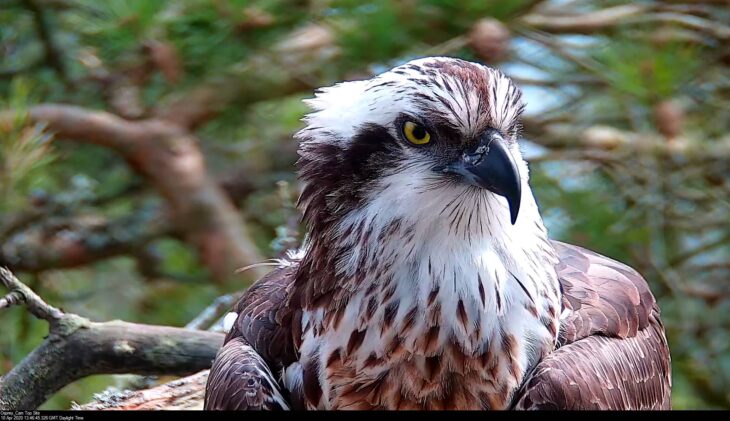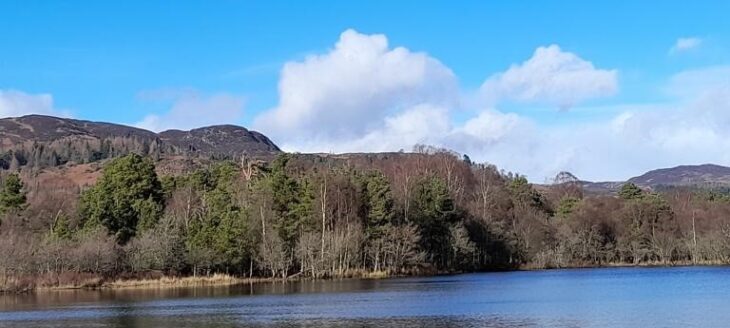Our osprey season is close to lift off
As the days lengthen and signs of spring emerge, our team at Loch of the Lowes Visitor Centre & Wildlife Reserve is eagerly preparing for the return of ospreys. The Trust’s Perthshire Ranger Sara Rasmussen shares a recap of 2020’s challenging season, and looks ahead to another exciting year.
Over the last few weeks our team, in conjunction with contractors Scottish Communications, has been working flat out through ice, snow, rain and floods to get everything in place for the season. We’re delighted to announce that our webcam?is now live!
With the 52nd osprey season at Loch of the Lowes about to begin I wanted to share a recap of last year, and also detail some of the changes that we have made to ensure that these magnificent birds of prey have a safe and secure place to breed.
The 2020 season – a recap
As many of you may remember our 51st season started on 21 March with the return of regular breeding male LM12. He quickly got to work, eagerly preparing the nest for the return of his mate LF15.
Sadly, despite being in her prime at around eight years of age, LF15 failed to return. While we’ll never know the exact circumstances, it’s possible she was a victim of particularly harsh northerly winds during migration.
It wasn’t long before we saw a new kid on the block. A young female, ringed Blue NC0, turned up on 28 March and quickly made her home on the nest. NC0 was ringed at a nest near Loch Ness in 2016, by the much-respected Brian Etheridge, Adam Ritchie and the late Ciril Ostroznik.

It took a while for the new pair to bond and get the hang of mating, but gradually they began to settle down. Things were looking good and we were looking forward to seeing a clutch of eggs, but the season had one further twist in store.
The pair faced a number of challenges. Following three separate incidents of human disturbance, multiple aerial intrusions by other ospreys and a period of sustained gales that blew out part of the nest, the birds abandoned the site on 12 April. This was the first time since 1990 that this nest failed to host a breeding attempt.
While lockdown made further observations difficult we were able to establish that the pair had taken up residence in a new location nearby. The female appeared to be sat on an egg on 16 April, which hatched around 23 May.
At least two eggs were laid by NC0 and hatched, as later in the season we saw two chicks being fed. One was noticeably much smaller than the other and sadly this chick died sometime around the week of 22 June.
With the lifting of lockdown it became easier to see how the family were progressing over the summer. LM12 and NC0 put in occasional appearances on the established nest and were both seen regularly flying on the reserve, washing their talons in the loch and eating fish in the vicinity of the loch.
We were delighted to see the juvenile osprey take its first flight around 17 July, and a couple of weeks later on 3 August NC0, began her long migration south. LM12 remained dutifully behind to continue to feed the young osprey, who due to Covid-19 restrictions was unable to be ringed, until it began its maiden journey to warmer climes on the afternoon of 29 August. LM12 followed the next day.
Preparations for the season ahead
After the birds left the reserve we faced some hard decisions about what, if anything, should be changed to ensure we continue to provide a safe and secure nesting place for ospreys at Loch of the Lowes.
The team took advice from leading osprey experts?on why the birds may have abandoned the nest, and what could be done to entice them back to the site.
While we’re always keen to take as light touch an approach as possible, encouraging birds to use the regular nest strengthens our ability to provide round-the-clock nest protection. It also provides a fantastic opportunity for people to observe ospreys, both in person and via the live webcam.

One factor that stood out was the line of sight for an osprey sitting on the nest. The extent of the tree canopy both above and below the nest meant any bird sitting on the nest would only see about 30% of the surrounding area, and would struggle to spot incoming intruding birds.
We decided to improve the outlook by removing the branches that were obstructing the view. Following this pruning, the tree now looks like a ‘classic’ osprey site. The nest itself appears as the high point on the Scots pine. The lines of sight are greatly improved, and the pruning also highlights the impressive scale and size of the 32-year-old nest.
We’re hopeful that these renovations help re-establish the historic nest as a prime piece of osprey real estate, and encourage the pair to take up residence once more.
Further work has been carried out to refresh the pine marten protection around the tree to prevent them climbing up and either creating a den in the nest itself or taking eggs. Turf and couch grass that has taken root in the last couple of seasons has been dug out.
As a final touch, the nest has been dressed with leaf mulch, recreating the classic ‘end of season’ effect that the returning birds will look out for.
We’re hopeful that these renovations help re-establish the historic nest as a prime piece of osprey real estate, and encourage the pair to take up residence once more.
As a further precaution, security cameras have been installed at last year’s nesting site to guard against disturbance, and to allow 24-hour nest protection to continue should the ospreys choose to breed there for a second time.
Sara ‘Raz’ Rasmussen
Perthshire Ranger
The Osprey Protection Programme at Loch of the Lowes Wildlife Reserve is supported by players of People’s Postcode Lottery.
Help protect Scotland’s wildlife
Our work to save Scotland’s wildlife is made possible thanks to the generosity of our members and supporters.
Join today from just £4 a month to help protect the species you love.
Preface
As the days lengthen and signs of spring emerge, our team at Loch of the Lowes Visitor Centre & Wildlife Reserve is eagerly preparing for the return of ospreys. The Trust’s Perthshire Ranger Sara Rasmussen shares a recap of 2020’s challenging season, and looks …
